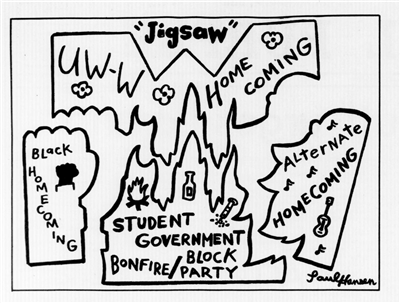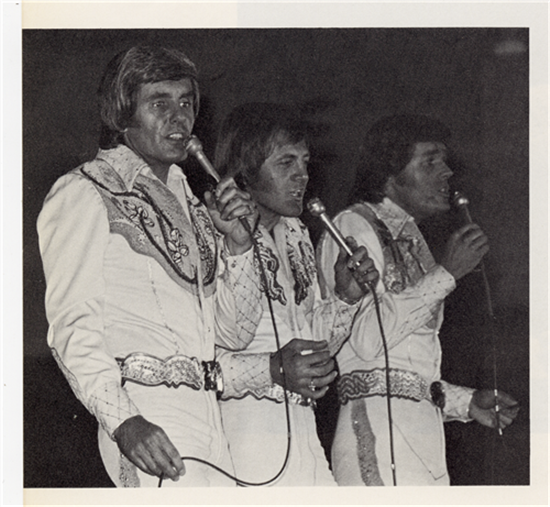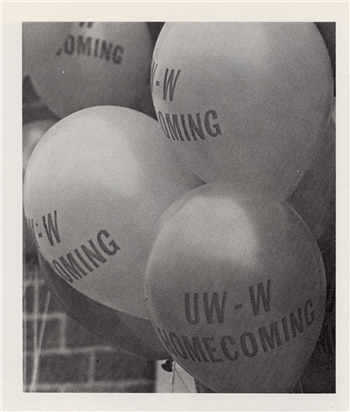Written by Dexter Neustadt
University of Wisconsin-Whitewater’s Homecoming theme for 1973 was “nostalgia,” although the various celebrations portrayed the theme of “Do Your Own Thing.”[1] Homecoming events began on Wednesday, October 10th, and lasted through Sunday evening. Events included a football game, a concert, a parade, a cookout, a dance, a block party, and a bonfire.[2] In addition, separate events were held at a Black Homecoming. The Homecoming Committee planned many activities without communicating with the student body, which led to discontent and frustration among the student body. For example, the committee decided on the band, The Lettermen, and so students who were dissatisfied with that decision planned an alternate concert. This lack of communication and dissatisfaction with decisions led some to believe Homecoming would be disjointed and chaotic.

On Thursday, October 11th, the homecoming king and queen election was held. This was the first time that candidates ran as couples. The winners would be crowned King and Queen, and the four remaining couples on the ballot would become their “court.”[3] Election results were announced at The Lettermen concert that evening.
The Lettermen were a well-known trio consisting of Tony Butala, Gary Pike, and Jim Pike. The concert’s first half focused on performances of current popular songs; then, the second half included songs popular in the ‘50s and ’60s– leaning into the theme of nostalgia. Many students were dissatisfied with the decision, stating that the University was “hitting new lows in attempting to abort audience’s highs.”[4] In response to disapproval of the Lettermen decision, Randy Buchek’s non-profit organization Alternative ‘73 put on a supplemental concert to give “this group of students an opportunity to attend a concert they will enjoy.”[5] The Alternative concert was set to feature Styx and Fiend’s Club, but it was canceled and rescheduled for the following week due to miscommunication and contract troubles.[6]

Two separate Homecoming dances took place on Saturday night: one for white students and one for black students. Each dance was held at a different time and location; they had different King-Queen couples and Courts and received different levels of advertising and reporting. Black Homecoming was held in Moraine dining hall, and the Queen was Princess Hill.[7] The dance for all other students was held at the University Inn, and L. A. Landgraf and Lu Ann Ripp were announced as the King and Queen, respectively.[8]
The Homecoming festivities concluded on Sunday with a block party sponsored by the student government. While some criticized the decision to host a party due to the recency of the death of four coeds in a car accident, the party proceeded problem-free. There was only one noise complaint, but no police reports were filed.[9]

In addition to the lack of communication and cohesion, Homecoming was criticized for a lack of unity. In a letter to the editor after the festivities, Tom Thomas wrote, “There’s The Lettermen concert, the Styx concert and now the Black Homecoming. Do we need three separate homecomings?”[10] Despite this criticism, Mary Schnuck claimed that all of the activities were worthwhile, explaining that the goal of many different activities was not for everybody to celebrate in their own way; instead, the goal was to provide people with dissimilar interests with an enjoyable homecoming experience.[11]
[1] “Disjointed Homecoming,” The Royal Purple, October 10, 1973.
[2] “Events Calendar,” The Royal Purple, October 10, 1973.
[3] “Pairs elected for homecoming court,” The Royal Purple, October 10, 1973.
[4] J. Nevins, “Zilch to Lettermen,” The Royal Purple, October 10, 1973.
[5] Randy Buchek, “Alternative ‘73 offers a choice,” The Royal Purple, October 03, 1973.
[6] Randy Buchek, “‘Styx’ sponsor apologizes,” The Royal Purple, October 17, 1973.
[7] [Minneiska 1973] pg 32
[8] “Homecoming ’73,” Minneiska, 1974, UW-Whitewater Archives and Area Research Center.
[9] “Party causes no problems,” The Royal Purple, October 24, 1973.
[10] Tom Thomas, “A call for togetherness,” The Royal Purple, October 17, 1973.
[11] Mary Schnuck, “All homecoming events worthwhile,” The Royal Purple, October 17, 1973.
